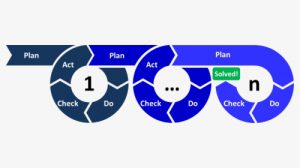PDCA CYCLE
What is PDCA Cycle?
PDCA is an iterative four-step management method used in business for the control and continuous improvement of processes and products. It is also known as the Deming circle/cycle/wheel, the Shewhart cycle, the control circle/cycle, or plan–do–study–act. Another version of this PDCA cycle is OPDCA.
While working with W. Edwards Deming in the 1950s, the Japanese adopted a process improvement methodology they referred to as the “Deming Cycle”. Today it is the fundamental core of “Kaizen”.
It was Deming that introduced the Japanese to the method, but the method itself was actually developed by his colleague Walter Shewhart.
Shewhart called his method PDCA.
In the 1990s Deming changed the name for the method that he used with clients from PDCA to PDSA. The new name reflected his preference for a change from “check” to “study” because with a “check”, one might miss something. However, PDCA has remained the most commonly used term in practice today.
Among the most widely used tools for the continuous improvement model is a four-step quality assurance method the plan-do-check-act (PDCA) cycle:
- Plan: Identify an opportunity and plan for change.
- Do: Implement the change on a small scale.
- Check: Use data to analyze the results of the change and determine whether it made a difference.
- Act: If the change was successful, implement it on a wider scale and continuously assess your results. If the change did not work, begin the cycle again.
Just as a circle has no end, the PDCA cycle should be repeated again and again for continuous improvement. The PDCA cycle is considered a continuous improvement tool.
Other widely used methods of continuous improvement, such as Six Sigma, lean, and total quality management, emphasize employee involvement and teamwork, work to measure and systematize processes, and reduce variation, defects, and cycle times.
Let’s now take a closer look at each step in the improvement cycle:
PLAN
The key aim in the first step of PDCA (planning stage) is to develop an intimate familiarity with the current state.
Learning about the process can take many forms, including conducting research and gathering data on various factors of the current situation: suppliers, inputs, process, outputs, and customers (SIPOC). You will need to determine, agree, and define issues and to evaluate potential strategies and actions that can overcome process issues.
Specific steps in the Plan stage
- Define what the process does and identify the start and endpoints.
- Describe the process: list the critical tasks performed and sequence of steps, people involved, equipment used, environmental conditions, work methods, and materials used.
- Identify everyone involved, such as operators, suppliers, and any external and internal customers.
- Understand and document customer expectations: what the customer wants, when, and where.
- Understand the process better by gathering any historical process performance data available or collecting current state data. If you have not already implemented machine monitoring, Evocon can save you considerable time with this step as it automates data collection and visualization.
- Learn and document any perceived problems associated with the process.
- Identify the root causes of problems and describe the impact on performance.
- Develop solutions that correct the root cause of the problems and prevent a recurrence.
- Select the best solution.
DO
The “Do” stage is when implementation begins on a small scale.
Small scale implementations can take the form of a limited pilot within a more extensive production process, or perhaps with a targeted group of clients. The point is to test the effectiveness of solutions by gathering and evaluated objective data.
Specific steps in the Do stage
- Conduct a pilot study or experiment to evaluate the possible solution(s) effect.
- Identify steps to measure the effectiveness of the improvements or solutions tested.
CHECK
The “Check” stage in PDCA determines whether the solution is working by assessing the outcomes, documenting learning, and determining whether additional problems or opportunities are required to be addressed.
Specific steps in the Check stage
- Examine the results of an experiment or pilot.
- Determine if the effectiveness of the process has increased.
- Decide if further testing is necessary
ACT
The “Act” stage is the last step in the PDCA cycle. The key focus here is to refine and finalize the changes that will be introduced.
Once standardized, the improvement must be established as the new “best practice” within the company.
Specific steps in the Act stage
- Select the best change or solution.
- Develop an implementation plan that explains who needs to do what and when.
- Formalize the solution, for example, by revising work instructions.
- Set up a method to track and monitor the performance of the process.

